Does India Need Foreign Contributions?
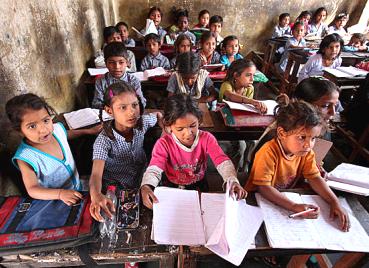
| Highlights* US continues to be the highest donor to India. * Delhi, Tamil Nadu get the most of aid funds. * Chennai-based World Vision Trust received the highest foreign aid in 2009-10. |
India is among the fastest growing economies in the world, and is the 9th largest economy with a GDP of $1.6 trillion in 2011… but the country is also ranked 7th among the recipients of overseas development assistance (ODA) after Afghanistan, Ethiopia, Pakistan, Tanzania, Vietnam and Haiti.
So, who provides the aid and who gets them? Equally, from a pure economic standpoint, does India need these contributions? For instance, former Finance Minister Pranab Mukherjee, during a visit to the United Kingdom, had said that India did not need UK aid.
IndiaSpend’s Prachi Salve looks at how much aid India gets by analysing the data from the Home Ministry and the Ministry of Finance for this article while there could be funds flowing in from other sources as well not accounted for by the ministries. The key findings: Small contributors account for most of the foreign aid, and social organisations working in the fields of health and education get maximum funds from the donors. And establishment expenses of these organisations accounted for over Rs 1,400 crore in 2009-10.
The Basic Rules
Foreign Contributions Regulations Act or FCRA permits organisations or associations to accept foreign contributions either by registration or prior permission from the central government under the Act.An association is defined as a collective with a cultural, economic, educational, religious or social agenda.
Nearly 21,500 out of the total 38,436 registered associations have submitted annual returns for the year 2009-2010 with the Home Ministry, which means nearly 16,920 organisations have not yet filed their returns with the Home Ministry.
How Much Money Is Coming In?
The total amount received as foreign contributions under FCRA was Rs 10,337.59 crore (over $2 billion) during the year 2009-10, according to the annual report published by the Home Ministry.
The graph shows the percentage change in foreign aid over the past decade
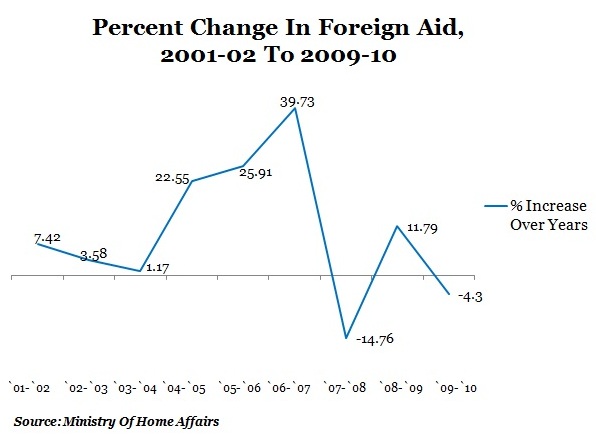
Table 1 below has the figures in a little more detail
Table 1: Foreign Contributions Through The Years
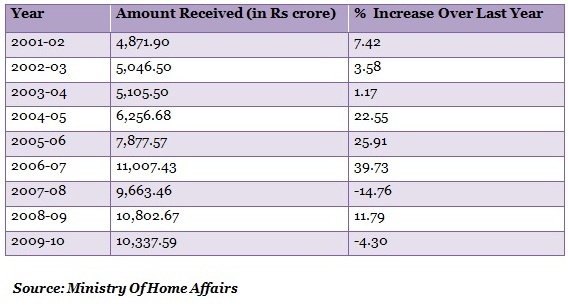
While there has been a decline in 2009-10 to Rs 10,337 crore from Rs 10,800 crore in 2008-09, the overall aid has been increasing every year.
Table 2: Small Contributors Top The List
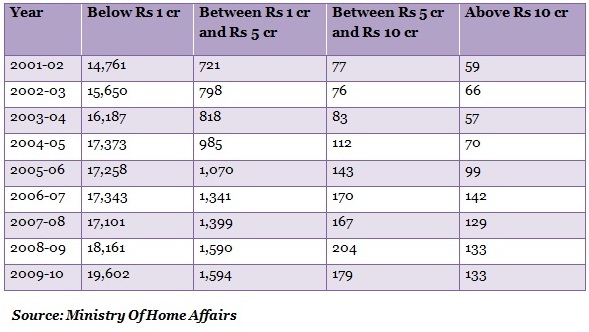
It can be seen from the table above that contributions below Rs 1 crore has always been higher than any other categories. But the other categories have also shown an increase over the years. For example, contributions between Rs 1 crore and Rs 5 crore has increased 49% to 1,594 from 1,070 in 2005-06.
Multilateral Aid Also Flowing In
India is a member of many multilateral organisations like the United Nations and the Asian Development Bank. So, the government receives interest-free loans, technical assistance for everything from economic development to gender equity and welfare. Table 3 shows receipts in the form of loans from multilateral organisations for 2009-2010 and 2010-11.
Table 3: Multilateral Aid
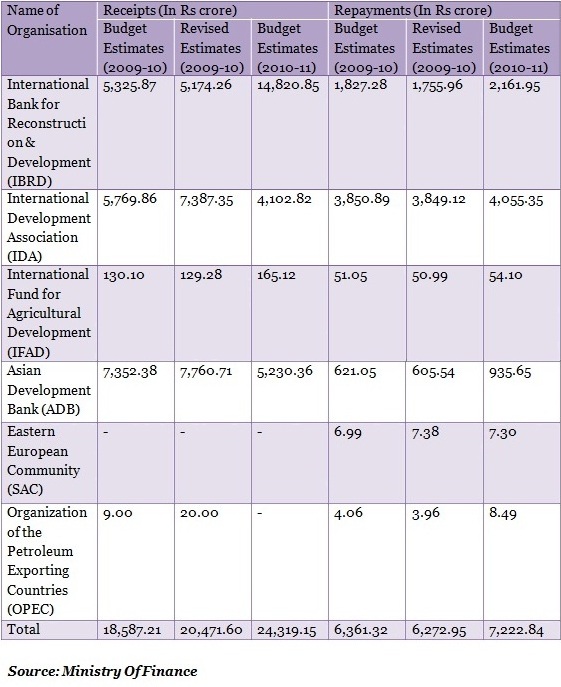
While India has increased its borrowing, there is an increase in the repayments as well. The highest receipts have been from IBRD while the highest increase in repayments has been to IDA. Interestingly, the Indian government has not received anything from SAC from 2009 to 2011 but has repaid nearly Rs 7.30 crore.
US Continues To Be A Big Donor
United States continues to be a major donor for India, and has contributed three times as much funding as Germany and UK, which were the second and third largest donors, respectively. The impact of the on-going recession is evident on fund flows as most countries have not increased aid for nearly three years. And there has been a decline in aid from the EU countries.
Table 4: Top 15 Donor Countries
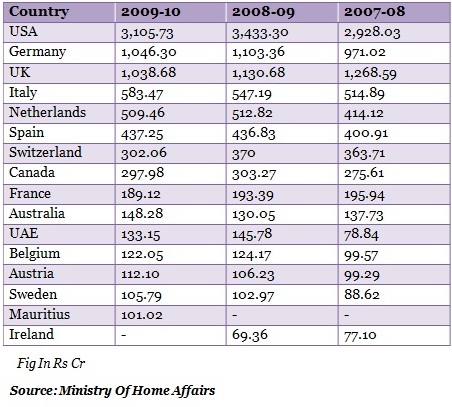
Education, Health Get Most Funds
Most of the aid to India (nearly 96%) comes in the form of sector-allocable funds followed by humanitarian and commodity aid(inflows of goods and services with no payments). Among social sector funding, most of it goes to health followed by education, reproductive programs, water supply, sanitation and civil society.
Table 5: Giving Education A Boost
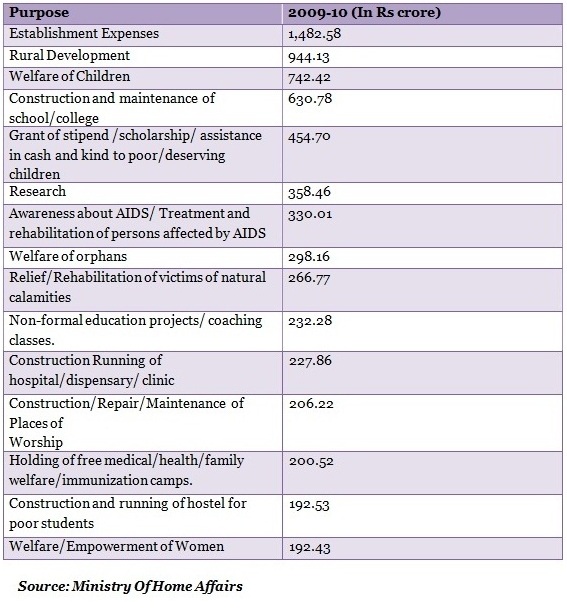
Delhi, Tamil Nadu Get Most Funds
Delhi has received the maximum aid from foreign contributors followed by Tamil Nadu while Rajasthan and Himachal have received the least amount of foreign aid.
Table 6: Top 15 States Receiving Foreign Aid
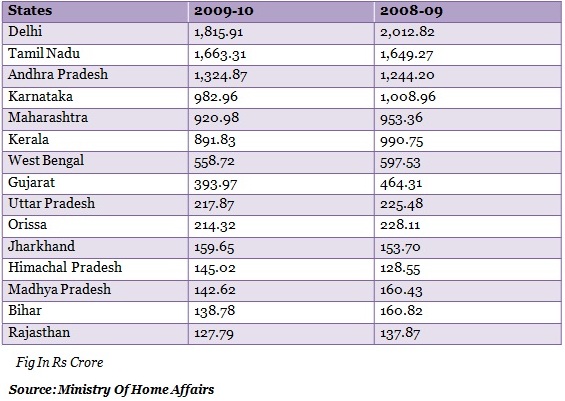
World Vision Trust Gets Rs 208 cr
World Vision Trust, Chennai received the highest foreign aid of Rs 208.94 crore in 2009-10 followed by the Rural Development Trust in Andhra Pradesh with Rs 151.31 crore. Table 7 lists the top 15 organisations in India that receive foreign contributions.
Table 7: Aid Flows To South India

Controlling Foreign Aid
The government has changed the policy around foreign aid and has limited the number of donor countries but has allowed development assistance to non-government organisations and universities…. and international aid is now concentrated on developing social sectors like education and health.
To answer the question we asked at the outset, does India need foreign contributions? It would appear that the monetary value is not much but the impact value could be arguably higher, particularly in some areas. It could also be argued that a sum like this or more can additionally be generated from within the country for the same or similar objectives. Once again, this is a pure economic statement.


